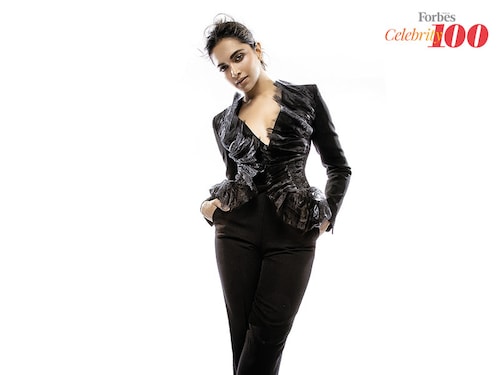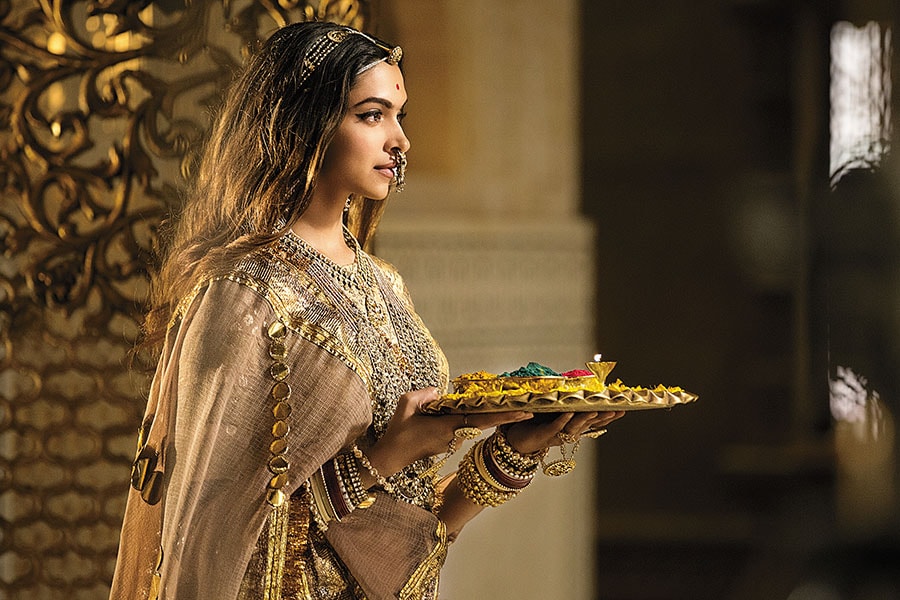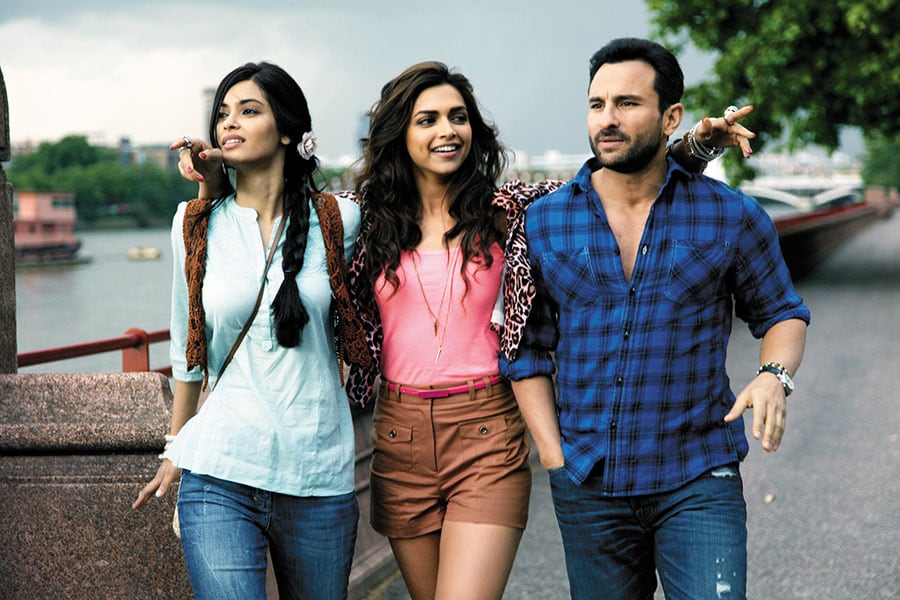Deepika Padukone: Taking centre stage
Deepika Padukone has had several hits over the past few years. With her latest, Padmaavat, she continues to be at the top of her game



Forbes India Celebrity 100 Rank No. 4
Image: Errikos Andreou
Leading the way down a flight of steps, with other Rajput women behind her, into a wall of flames with a smile of victory was the last time we saw Deepika Padukone on screen.
In person, she’s sitting across us at a five-star hotel in suburban Mumbai, without a hint of make-up. Her hair is tied in a simple bun, she is wearing a black oversized hoodie and sneakers, and the smile that has lit up the screen, from her role as Shantipriya in her debut film Om Shanti Om to Rani Padmavati in Padmaavat.
She has reasons enough to smile. It’s five days before her wedding with actor Ranveer Singh. And Padmaavat, for which she reportedly earned ₹12 crore, has been, at ₹300 crore, the highest grossing movie this year. That puts her right at the top of her game as well as makes her the first female celebrity to make it into the top five of the Forbes India Celebrity 100 list. She has consistently delivered hits in the last six years, be it large-scale films like Goliyon Ki Raasleela Ram-Leela (2013) and Bajirao Mastani (2015) or smaller films like Finding Fanny (2014) and Piku (2015, which made ₹151 crore), proving herself to be one of the most bankable actors in the industry.
Not that she planned on an eclectic mix of movies or picked them with an eye on the box office alone. “A film like Finding Fanny was not made with the intention of making ₹100 crore or anything of that sort. A bunch of us had this little quirk that we wanted to do this film and we had a producer who was willing to fund it and we went for 30 days, did the film and came back. We managed to do and execute exactly what we had in mind and have that experience we wanted to get it out of our system and we did that. So, from a film like that to a film like Padmaavat or Ram-Leela or Chennai Express, films have done better than what I expected, but I don’t think in recent times any film has underperformed,” she says.
Certainly not since her 2012 hit Cocktail. Before that, though she was picking movies that apparently ticked all the right boxes (from Karthik Calling Karthik with Farhan Akhtar to Break Ke Baad with Imran Khan, both in 2010), the movies didn’t do as well as she expected.
But something changed with Cocktail. Not just in terms of the challenge as an actor, but the way in which she looked at films. “Initially, when I read the script I was asked to pick between Meera and Veronica’s characters, and I chose Meera’s because she was more relatable. Later, Imtiaz [Ali, who wrote the script] asked me to look at the script from Veronica’s point of view, and when I was reading it, I had butterflies in my stomach. That’s when I realised someone was really challenging me as an actor,” she says.
Since then, she has taken on stronger and bolder roles, including Leela in Goliyon Ki Raasleela Ram-Leela, Mastani in Bajirao Mastani and even Tara in Tamasha (2015). She believes she got more clarity about the kind of roles she wished to do after Cocktail.
“Initially, I had a tough time because I was so new and naïve in the industry. Over time, I’ve learnt that there is no set formula to being successful. But when it comes to choosing roles, I rely 100 percent on my instinct, and whether I can connect to the story,” she says.
“Over the years she has learnt how to choose the script that will do justice to her and the entire crew. So we don’t get involved in these things and most of the time she doesn’t even tell us what the story is,” says her younger sister, Anisha.
Padukone has also progressively taken on more challenging roles. “With Mastani, I had a lot of external crutches that I could use to show strength or vulnerability [with a sword in her hand or as a mother], whereas with Padmavati, her resilience, power and strength had to come through her eyes and her demeanour,” she adds.
*****
It’s been just over a decade since Padukone entered the industry. The film industry is known to be a lot tougher for ‘outsiders’, but Padukone was always determined. Moving out of her comfort zone—home (Bengaluru) and the badminton court—to an entirely new city (Mumbai), and exploring a profession known to be emotionally and mentally draining, took a lot resilience for the then 21-year-old. “There was a lot of learning and discovering that I had to do. To step into an industry with no family or friends was exciting and unnerving at the same time. I have travelled this journey on my own a lot of rights and wrongs, all have led me to where I am today,” she says.  Padmaavat, Padukone’s last release, earned more than ₹300 crore in the domestic box office
Padmaavat, Padukone’s last release, earned more than ₹300 crore in the domestic box office
Image: Bhansali Productions Pvt. Ltd.While the battle was hers to fight, she credits a lot of her success to her family’s support. After all, pushing boundaries, and going against the norm to pursue dreams, runs in the family and is, in fact, encouraged. “If I could board a flight from Bangalore every few weeks, to come here and do auditions and meetings, and do that without any doubt or fear, it’s because my family was happily and willingly letting me go,” she says. “I never had to hide or lie, or do it with any sense of fear, and that is something my grandparents inculcated in my parents, because my father decided to become a professional badminton player at a time when people were doctors or lawyers or engineers. And that too badminton of all sports, something India was not even known for. So for my father to do that, and for my grandfather to allow my father to take up the sport and move to Denmark for training, allowed my parents to do the same with my sister and me. Nobody in our family has been a model or an actor, but they had faith and they allowed me to do what I did.”
It’s a question she is asked often, but her parents were never shocked at her decision to become an actor, says Padukone who, while in school, was never interested in academics and was always more into extra-curricular sports or theatre. “Even though I was probably just a tree at the back of the stage, those were always my areas of interest. So, when I spoke to them, there was no agitation they accepted it, and it continues to be like that.”
In fact, growing up together, Anisha says she clearly saw the potential star in her sister. “Deepika and I were in the same school until I was in fourth grade. She always loved to participate in school plays, dancing, and performing for the teachers on Teachers’ Day, the usual things kids do in school. One incident our mother tells us about is that during one of her performances in school she imitated the principal, and that too in a convent school, where things like these are not easily accepted. Surprisingly, everyone loved her act because it was so good.”
*****
Padukone made her way to Bollywood in a measured manner. After a few advertising assignments, she trained under fashion choreographer and designer Prasad Bidapa, with the goal of becoming a full-time model. In 2005, she made her debut on the ramp at Lakme Fashion Week and in 2006, in a music video by Himesh Reshammiya as well as on the Kingfisher calendar. Which is when Bollywood choreographer and director Farah Khan spotted the Shantipriya she was looking for.
When Padukone broke the news about this to her family, and the fact that she was going to work with actor Shah Rukh Khan, it was very difficult for them to believe it. “When she informed us that Farah Khan had promised her a movie with Shah Rukh Khan, we were a bit sceptical and asked her not to stop looking for more options. But when we realised she has actually signed the contract, all of us were very happy,” says Anisha. Her family was overwhelmed, but also unsure about how things would turn out because it could have gone either way. Padukone’s work in Cocktail was a turning point in her choices as an actor
Padukone’s work in Cocktail was a turning point in her choices as an actor
As it turned out, Om Shanti Om made ₹150 crore worldwide. “Her first film was a double role, where the two characters were very different. She played both roles, which are diametrically opposed, so effortlessly that you could tell right there in her first film what her strength and potential is as a performer,” says director Meghna Gulzar, who is working with Padukone for her next project, where the actor will play acid attack survivor Laxmi Agarwal.
It’s another role Padukone picked instinctively. “I was not in a mind space to do another heavy film, but then Meghna and I met, she narrated the film and in couple of minutes I said yes, because somehow it just felt right. Now I’m doing exactly what I didn’t want to do because the conviction has directly come from the director and it just feels correct,” she says.
Meghna, whose last film Raazi crossed ₹100 crore at the box office, believes that Laxmi’s story deserves to be told. “After the narration, I shut my iPad. The story ends in such a way that you really don’t have much to say there is a kind of cloud of silence that hangs around. Deepika and I were just sitting and looking at each other, and she just smiled and said, ‘Ya, okay!’ It was a very surreal moment for me,” says Meghna.
“She listens to the director as much as possible, and more than anything else, she needs to acclimatise herself to the set. Unlike a lot of other actors, she doesn’t need too many rehearsals she is bang on in the first two or three takes,” says director Shoojit Sircar who worked with Padukone in Piku.
*****
Even as her career was thriving and she was well on her way to becoming one of Bollywood’s most sought-after actors, Padukone was battling mental illness. Elaborating on her decision to go public about her struggles with depression, the 32-year-old actor says, “I think depression is a time when you have moments of weakness and you really want to give up because it’s exhausting, tiring, frustrating.” It helped that she had a solid support system in place, including Ranveer Singh. “Ranveer isn’t the kind of person who understands what going through depression feels like. But what made me feel comfortable is being vulnerable in front of him without the fear of being judged, which was a great support.”
[qt]There’s no set formula to being successful. But in choosing roles, I rely 100% on my instincts.”[/qt]
Her experiences battling depression and the stigma surrounding it made her set up The Live Love Laugh Foundation. “While I was going through that experience I had to keep everything hushed. I felt very caged when I wanted to cry I had to do it in the bathroom or privately. That’s when I realised the stigma attached to it. How do we tell people, or should we tell people? So, once I got better the first question it triggered was, ‘why don’t people talk about it?’ That’s when I decided to come out and talk about it,” she says.
It’s just been one more step in her journey of self-discovery and her achievements as an actor and a person. “I think for me achievement is self-awareness and inner peace. And if you are talking about that achievement, then I have come a long way, because that’s where I am. To be at peace with yourself is what achievement means to me,” she says. “If you had asked me this question a couple of years ago, I would’ve said that I have achieved a lot, but I have a lot more to achieve... of course, everyone has a lot more to achieve, everyone has a lot to learn, to grow, to discover, and to process. I think in a lot of other ways I feel like I am very happy with my evolution, and how self-aware I am about my breathing, my existence, about all of these things… I am in a good space.”
First Published: Dec 07, 2018, 08:45
Subscribe Now